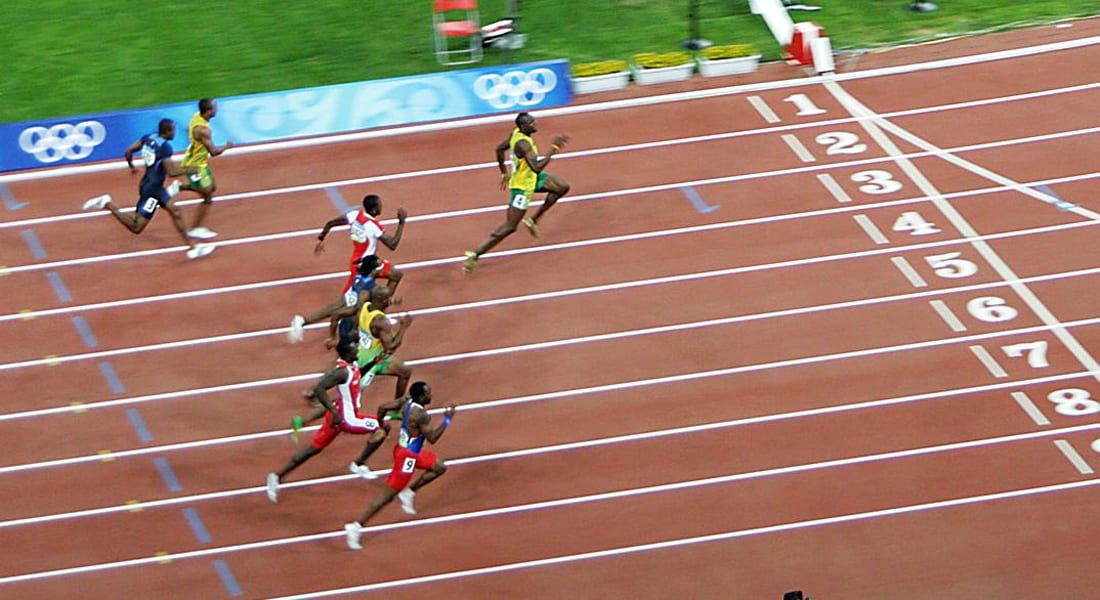The researchers assessed Bolt’s running using a new motion-based method to test how hard and fast each foot hits the ground.
Journalist Lance Murray with D Magazine’s Dallas Innovates covered the research of SMU biomechanics expert Peter Weyand and his colleagues Andrew Udofa and Laurence Ryan for a story about Usain Bolt’s asymmetrical running gait.
The article, “SMU Researchers: Usain Bolt’s Gait is Asymmetrical,” published July 5, 2017.
The researchers in the SMU Locomotor Performance Laboratory reported in June that world champion sprinter Usain Bolt may have an asymmetrical running gait. While not noticeable to the naked eye, Bolt’s potential asymmetry emerged after the researchers dissected race video to assess his pattern of ground-force application — literally how hard and fast each foot hits the ground. To do so they measured the “impulse” for each foot.
Biomechanics researcher Udofa presented the findings at the 35th International Conference on Biomechanics in Sport in Cologne, Germany. His presentation, “Ground Reaction Forces During Competitive Track Events: A Motion Based Assessment Method,” was delivered June 18.
The analysis thus far suggests that Bolt’s mechanics may vary between his left leg to his right. The existence of an unexpected and potentially significant asymmetry in the fastest human runner ever would help scientists better understand the basis of maximal running speeds. Running experts generally assume asymmetry impairs performance and slows runners down.
Udofa has said the observations raise the immediate scientific question of whether a lack of symmetry represents a personal mechanical optimization that makes Bolt the fastest sprinter ever or exists for reasons yet to be identified.
Weyand, who leads the lab and its researchers, he is an expert on human locomotion and the mechanics of running. He is Glenn Simmons Professor of Applied Physiology and professor of biomechanics in the Department of Applied Physiology & Wellness in SMU’s Annette Caldwell Simmons School of Education & Human Development, is director of the Locomotor Lab.
EXCERPT:
By Lance Murray
Dallas Innovates
When it comes to running, nobody does it faster than Usain Bolt, the eight-time Olympic champion and triple world record holder.The lanky Jamaican sprinter is known for his explosive acceleration down the track and the famous images of him looking back as he leaves his competitors in his wake.
You’d think Bolt’s powerful legs work as a symmetrical team propelling him at great speed toward the finish line, but according to researchers at Southern Methodist University, Bolt’s gait may, in fact, be asymmetrical.
SMU researchers examined the running mechanics of Bolt, who is considered the world’s fastest man.
The analysis, so far, suggests that his mechanics may vary from his right leg to his left, according to Andrew Udofa, a biometrics researcher in the SMU Locomotor Performance Laboratory.
According to a blog on SMU Research News, most running experts assume that asymmetry impairs performance and slows a runner down. This unexpected asymmetry in Bolt’s mechanics could help scientist better understand the basis of maximal running speeds, according to the university.
“Our observations raise the immediate scientific question of whether a lack of symmetry represents a personal mechanical optimization that makes Bolt the fastest sprinter ever or exists for reasons yet to be identified,” Udofa, a research team member, said in the blog.




